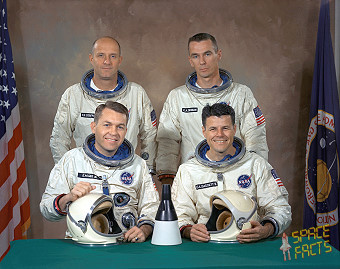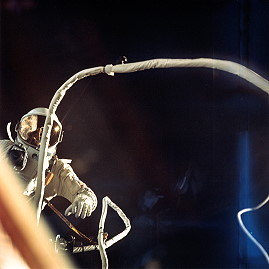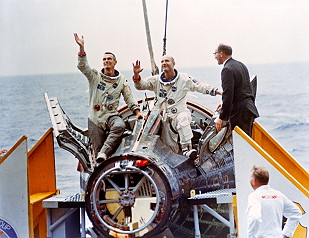Human Orbital Spaceflights
![]()
International Flight No. 19Gemini 9AUSA |
 |
 |
![]()
Launch, orbit and landing data
walkout photo |
 |
||||||||||||||||||
Crew
| No. | Surname | Given names | Position | Flight No. | Duration | Orbits | |
| 1 | Stafford | Thomas Patten "Tom" | Command Pilot | 2 | 3d 00h 20m 50s | 45 | |
| 2 | Cernan | Eugene Andrew "Gene" | PLT | 1 | 3d 00h 20m 50s | 45 |
Crew seating arrangement
|
 |
Backup Crew
|
 |
|||||||||||||||
original crew photo |
Hardware
| Launch vehicle: | Titan II GLV No. GT-9 (62-12564) |
| Spacecraft: | Gemini 9 (S/C-9 No. 2347) |
Flight
|
Launch from Cape Canaveral and landing 500 km
east of Cape Canaveral in the Atlantic Ocean. The Gemini spacecraft was a cone-shaped capsule consisting of two components, a reentry module and an adaptor module. The adaptor module made up the base of the spacecraft. It was a truncated cone 228.6 cm high, 304.8 cm in diameter at the base and 228.6 cm at the upper end where it attached to the base of the reentry module. The re-entry module consisted of a truncated cone which decreased in diameter from 228.6 cm at the base to 98.2 cm, topped by a short cylinder of the same diameter and then another truncated cone decreasing to a diameter of 74.6 cm at the flat top. The reentry module was 345.0 cm high, giving a total height of 573.6 cm for the Gemini spacecraft. The adaptor module was an externally skinned, stringer framed structure, with magnesium stringers and an aluminum alloy frame. The adaptor was composed of two parts, an equipment section at the base and a retrorocket section at the top. The equipment section held fuel and propulsion systems and was isolated from the retrorocket section by a fiber-glass sandwich honeycomb blast shield. The retrorocket section held the re-entry rockets for the capsule. The reentry module consisted mainly of the pressurized cabin which held the two Gemini astronauts. Separating the reentry module from the retrorocket section of the adaptor at its base was a curved silicone elastomer ablative heat shield. The module was composed predominantly of titanium and nickel-alloy with beryllium shingles. At the narrow top of the module was the cylindrical reentry control system section and above this the rendezvous and recovery section which holds the reentry parachutes. The cabin held two seats equipped with emergency ejection devices, instrument panels, life support equipment, and equipment stowage compartments in a total pressurized volume of about 2.25 cubic meters. Two large hatches with small windows could be opened outward, one positioned above each seat. Attitude control was effected by two translation-maneuver hand controllers, an attitude controller, redundant horizon sensor systems, and reentry control electronics, with guidance provided via an inertial measuring unit and radar system. The orbital attitude and maneuver system used a hypergolic propellant combination of monomethyl hydrazine and nitrogen tetroxide supplied to the engines by a helium system pressurized at 2800 psi. Two 95 lb translation thrusters and eight 23 lb attitude thrusters were mounted along the bottom rim of the adaptor, and two 79 lb and 4 95 lb thrusters were mounted at the front of the adaptor. Power was supplied by 3 silver-zinc batteries to a 22- to 30-volt DC two-wire system. During reentry and post-landing power was supplied by four 45 amp-hr silver-zinc batteries. Voice communications were performed at 296.9 MHz with an output power of 3 W. A backup transmitter-receiver at 15.016 MHz with an output power of 5 W was also available. Two antenna systems consisting of quarter-wave monopoles were used. Telemetry was transmitted via three systems, one for real time telemetry, one for recorder playback, and a spare. Each system was frequency-modulated with a minimum power of 2 W. Spacecraft tracking consisted of two C-band radar transponders and an acquisition-aid beacon. One transponder is mounted in the adaptor with a peak power output of 600 W to a slot antenna on the bottom of the adaptor. The other is in the reentry section, delivering 1000 W to three helical antennas mounted at 120-degree intervals just forward of the hatches. The acquisition-aid beacon was mounted on the adaptor and had a power of 250 mW. At the time of reentry, the spacecraft would be maneuvered to the appropriate orientation and equipment adaptor section would be detached and jettisoned, exposing the retrorocket module. The retrorockets consisted of four spherical-case polysulfide ammonium perchlorate solid-propellant motors mounted near the center of the reentry adaptor module, each with 11,070 N thrust. They would fire to initiate the spacecraft reentry into the atmosphere, with attitude being maintained by a reentry control system of 16 engines, each with 5.2 N thrust. The retrorocket module would then be jettisoned, exposing the heat shield at the base of the reentry module. Along with the ablative heat shield, thermal protection during reentry was provided by thin Rene 41 radiative shingles at the base of the module and beryllium shingles at the top. Beneath the shingles was a layer of MIN-K insulation and thermoflex blankets. At an altitude of roughly 15,000 meters the astronauts would deploy a 2.4-meter drogue chute from the rendezvous and recovery section. At 3230 meters altitude the crew releases the drogue which extracts the 5.5-meter pilot parachute. The rendezvous and recovery section are released 2.5 seconds later, deploying the 25.6-meter main ring-sail parachute which is stored in the bottom of the section. The spacecraft is then rotated from a nose-up to a 35-degree angle for water landing. At this point a recovery beacon is activated, transmitting via an HF whip antenna mounted near the front of the reentry module. The Astronaut Maneuvering Unit (AMU) was a 75 kg backpack, 81 cm high, 56 cm wide, and 48 cm deep, mounted on the rear of the Gemini capsule adapter section. It had a form-fitting seat, a 45-meter nylon tether, and self-contained life-support, communications, telemetry, propulsion, and manual and automatic stabilization systems. The propulsion system consisted of 12 small thrusters mounted on the corners of the pack using a hydrogen peroxide fuel supply and thruster controls on two sidearm supports. The backpack could be accessed by a spacewalking astronaut who would move to the back of the craft, put on the backpack, and disconnect the spaceship tether and oxygen supply before using the AMU. The Augmented Target Docking Adapter (ATDA) had been prepared as a backup target in case of an Agena Target Vehicle failure. The ATDA was a short cylinder consisting of a target docking adapter cone mounted on front and containing a communications system, a guidance and control system, and a reaction control system. It also had running lights, but unlike the Gemini Agena Target Vehicles, the ATDA was not stabilized. The Gemini 9 Augmented Target Docking Adapter (ATDA) was launched from Cape Canaveral using an Atlas-Agena D rocket at 15:00:02.363 UTC on June 01, 1966. The spacecraft was successfully injected into a near-circular 304 km orbit, but telemetry signals indicated that the launch shroud, which covered the docking adaptor, had separated but had not been jettisoned. The original prime crew (Elliot See and Charles Bassett) was killed in a T-38 training airplane crash on February 28, 1966, so their backups Thomas Stafford and Eugene Cernan became the new prime crew. Astronauts James Lovell and Buzz Aldrin became the new backup crew. On the February 28, 1966, Elliot See and Charles Bassett were flying from Texas to inspect the Gemini 9 spacecraft at the McDonnell Aircraft plant in St. Louis, Missouri. The conditions at Lambert Field were poor and, as a consequence, in attempting a visual approach and landing, Elliot See hit one of the assembly buildings of the factory and caused the aircraft to crash, killing himself and Charles Bassett instantly. The main goals of this mission were to rendezvous and dock with the Augmented Target Docking Adapter (ATDA) and to conduct extravehicular activities (EVA). Gemini 9A was launched on June 03, 1966 from Complex 19 at 13:39:33.335 UTC and inserted into a 158.8 x 266.9 km orbit. The launches of the ATDA and of Gemini 9A were successful, but the docking with the Augmented Target Docking Adapter ATDA was not achieved because the shroud on the ATDA failed to separate. It looked like an "angry crocodile". Thomas Stafford had made the first thruster burn 49 minutes after launch, to add 22.7 meters per second (74 ft/s) to their speed, raising their perigee from 160 to 232 kilometers (86 to 125 nmi). An hour and 35 minutes later, Thomas Stafford corrected phase, height, and out-of-plane errors by pointing the spacecraft 40° down, and 3° to the left. Fifty-one seconds later, he fired the thrusters again to add 16.2 meters per second (53 ft/s) to their speed and put them into a 274-by-276-kilometer (148 by 149 nmi) orbit, closing at 38 meters per second (120 ft/s) on the ATDA. The first radar contact with the target registered a distance of 240 kilometers (150 mi) away and they had a solid lock at 222 kilometers (138 mi). Their first visual sighting came 3 hours and 20 minutes into the mission, when they were 93 kilometers (58 mi) away. As they got closer, they found the ATDA to be in a slow rotation, with the conical nose shroud still attached, the two pieces hanging agape at the front like a giant, open jaw. Eugene Cernan performed an EVA on June 05, 1966 (2h 09m). The objective of this EVA, evaluation of the astronaut maneuvering unit (AMU), was not achieved. The AMU had its own propulsion, stabilization system, oxygen and telemetry for the biomedical data and systems. It used hydrogen peroxide for propellant, and because it produced extremely hot gases. Eugene Cernan just before orbital dawn. He used an Environmental Life Support System (ELSS) chest pack similar to the one David Scott would have used on Gemini 8. His suit legs were modified with steel fabric and aluminized film layers to ward off heat from the AMU's hydrogen peroxide rockets. The thick, complex tether proved difficult to manage (Eugene Cernan called it "the snake"). Then Eugene Cernan moved to the AMU. Handrails, velcro pads, and loop foot restraints failed to help him control his movements. Eugene Cernan stated later that he "had to work continually against the pressure suit. . . I was devoting 50 percent of my workload just to maintain position." As he struggled, he broke off an experiment antenna mounted on Gemini 9A and tore the outer layers of his suit. His exertions exceeded the capacity of the ELSS to remove moisture, fogging his faceplate and blinding him. Eugene Cernan donned the AMU by touch, but Thomas Stafford called him back inside. Eugene Cernan also experienced "hot spots" on his back caused by sunlight striking torn places on his suit. After returning to Earth, Eugene Cernan conducted underwater neutral buoyancy simulations of his EVA in the Weightless Immersion Facility pool at NASA MSC. He reported that neutral buoyancy simulation nearly duplicated actual EVA conditions, helping to validate it as an EVA training tool. At the end of his EVA he had big problems to return into the capsule and to close the hatch. Thomas Stafford had to help him. Eugene Cernan later was bitterly disappointed that he had been unable to fly the Air Force's maneuvering unit. The crew also performed several other experiments, so as bioassay of body fluids (the only medical experiment onboard). A micrometeorite collection package (mounted on the ATDA) should had been picked by Eugene Cernan during his EVA. Due of his blindness from the fogging face plate, he only was able to take some photos of this package. Another package was mounted on the Gemini capsule and could be retrieved. Other experiments were the zodiacal light photography and the airglow horizon photography, which were partly successful, but also impaired through Eugene Cernan's problems during his spacewalk. The splashdown, only 3 km far from the recovery ship, the USS Wasp, was broadcast live on TV. |
EVA data
| Name | Start | End | Duration | Mission | Airlock | Suit | |
| EVA | Cernan, Eugene | 05.06.1966, 15:0? UTC | 05.06.1966, 17:0? UTC | 2h 09m | Gemini 9A | G4C No. 32 | |
| IVA | Stafford, Thomas | 05.06.1966, 15:0? UTC | 05.06.1966, 17:0? UTC | 2h 09m | Gemini 9A | G4C No. 17 | |
Photos / Graphics
 |
 |
 |
 |
 |
 |
 |
 |
 |
 |
 |
 |
 |
 |
 |
 |
 |
 |
 |
 |
| © |  |
Last update on August 11, 2020.  |
 |